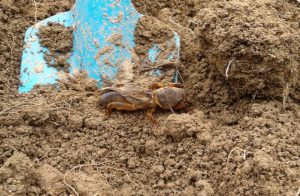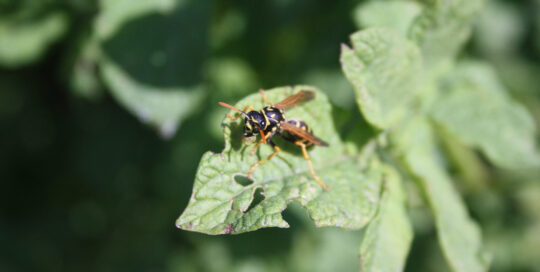How to Deal with Mole Crickets
Views: 6580

Leave it up to my sister-in-law to come through with some interesting garden pests. This weekend she posted a picture of a mole cricket she found while working in their garden. While my 10 year old son sincerely wants one as a pet, I am very happy they are predominantly found in warmer climates. In the United States, the Southwest is prime habitat for them. Although, according to the Texas Invasive Species Institute there has also been a mole cricket identified in Yuma, Arizona.
Mole Crickets
Mole crickets earn their name due to their unique anatomy and choice of habitat. They are over an inch long, and what’s particularly disturbing when I envision a cricket, they have strong forelegs for digging. Yes, digging crickets. Unlike the above-ground crickets we’re used to seeing in the garden, and sometimes the house, they live underground and eat plants at the root level. As you can imagine, they are a huge problem for those who like their lawns green and free of huge damaged areas.
Thankfully, mole crickets typically produce only one generation per year (except for a specific species in Florida), and mating occurs in February or March when the soil temperature reaches above 70 degrees F. where the males call to the females from a special chamber they created in the ground. Once they find each other, a brief mating flight happens before the female lays her eggs in an area 1 to 12 inches deep within the soil. I usually less than a month, the eggs hatch and go through up to 10 nymph stages prior to maturation. Unfortunately, they’re destructive during the entire cycle.
Getting rid of them
But how do we handle these little darlings? One way to determine if you’re at a level where you need to treat them is to trap them. There are a number of possibilities include a cone type trap or an acoustic trap that researchers sometimes use, but is a bit beyond what most homeowners would want to do. One way I thought was really cool was how we used to catch nightcrawlers. Mix a couple of tablespoons of dish soap into a gallon of water, and douse a 2 ft. x 2 ft. area. If they emerge, even if they are nymphs, you need to figure out a treatment plan.
Nematodes, particularly Steinernema scapterisci, appear to be effective against mole crickets, although finding this specific type can be a challenge. The Larra bicolor wasp is another possibility for those who wish to go an organic route. The wasp enters one of the mole cricket tunnels, and actually makes it emerge to the surface. It stings it, then lays an egg on the cricket, not in it like some other wasps. But the end result is the same. When the wasp hatches, it has an instant food source.
On the chemical front, there is a greater list of possibilities to use against them, but these might not be good choices for a food plot. For a homeowner, products using a carbaryl bait often works, as well as permethrin products. As always, carefully read the label and follow the instructions to ensure the most effective, and safest, treatment.
Even if my eldest thinks otherwise, I’m certainly happy we don’t have mole crickets. It’s one of those things that when I’m whining about our shorter season and cold weather, I can remind myself to be grateful that I “live in a place where the air hurts my face” so we don’t have to deal with these types of pests.
I credit the lovely photo to my sister-in-law, Emily, who obviously gardens in a warmer climate.
Meet Amy Grisak
Amy is a freelance author and photographer in Great Falls, MT who specializes in gardening, foods, and sustainable agriculture. She provides information on every kind…
Amy's Recent Posts

Looking into the Crystal Ball for a Pest Report








